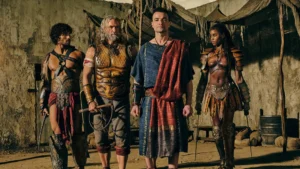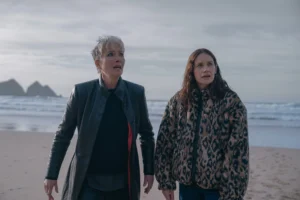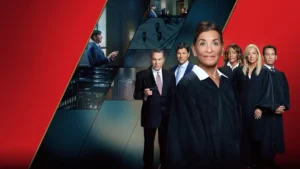Series Title: Star Trek: The Original Series
Episode Title: “The Cage”
Season: 1
Episode No.: 0
Network: Netflix
Air Date: October 4, 1988 (originally unaired)
Written By: Gene Roddenberry
What happened?
Captain Christopher Pike and the crew of the starship Enterprise answers a distress call emanating from Talos IV. Upon beaming down to the planet, Pike meets the sole human survivor of a shipwrecked colony, Vina, whom the Talosians have cared for as best they can. But she’s alone and in desperate need of a real, human companion. So, Pike finds himself the victim of an elaborate and deadly series of mind games by the planet’s underground inhabitants, hoping to keep him there forever as Vina’s companion – and as a part of their zoo.
What’s going on here?
This is the first entry in a new Flashback feature series, in which I’ll rewatch each episode of Star Trek: The Original Series (I’ll often abbreviate this as TOS). I’m a lifelong, ardent fan of Star Trek, in each of its forms, and I’m really excited to get started chronicling this journey. I’ll watch each episode according to Netflix’s order, and I’ll try to note when Netflix deviates from the normal, accepted (usually production) order, especially when it seems particularly important.
This will mostly be more of a review than a recap – I’d love for you all to watch along with me and join in the conversation. So, I’ll provide a short recap, but mostly I’ll give my thoughts on the episode as a part of the larger Star Trek narrative and thematic discussion. I don’t plan on really tackling canon quibbles; rather, I’d like to comment on the spirit of Trek, where other series build upon or support what’s going on in the episode, or if there seem to be any big contradictions or errors. I’ll often refer to different sources like Memory Alpha, Chrissie’s Transcripts Site, this amazing book: The Fifty-Year Mission, The First 25 Years, which is an unauthorized oral history of Star Trek by Edward Gross & Mark A. Altman or Marc Cushman’s in-depth These Are the Voyages books.
Also, because Star Trek: Discovery is on now, I’ll try to take particular note of how I’m seeing echoes of TOS in the newest addition to the franchise. This will be the first time I’ve done any rewatching of Star Trek since the premiere of Discovery, so I’m interested to see how it colors my thinking.
This recap and review will be a bit longer than usual, as I’m essentially reviewing the first in an entirely different series, which is, at the same time, the first in this classic franchise.
How did this crazy thing come to be and why is this an unaired episode? And why are we watching it if it was never aired during Star Trek’s The Original Series original run?
Wow. That’s a lot of questions.
In short, Gene Roddenberry, the creator of Star Trek, conceived of this series as a western in space, “Wagon Train to the stars,” with a starship trekking, or “voyaging from star to star” (Gross & Altman 32). Eventually, Roddenberry gathered around him some of the best science fiction writers of the time to help him tell some amazing tales of morality and social commentary. But first, just like any other TV show, Gene was asked to write and shoot a pilot episode.
In 1964, he wrote and produced this first episode, first called “The Menagerie, Parts I & II,” but ultimately calling it “The Cage” because the original title was eventually reused in an episode that actually aired, but more on that when the time comes. NBC ultimately passed on this pilot because it was too deep, “too atypical,” as Oscar Katz said (Gross & Altman 90). However, normally, when a pilot is declined, that’s the end of the road, but NBC commissioned a second pilot, which is “enormously rare” in the industry (Gross & Altman 90).
That second pilot, titled “Where No Man Has Gone Before,” revamped quite a lot of the look and feel of “The Cage,” so what’s left here is often difficult to reconcile with canon. Spock looks much harsher and more alien – he also smiles – the uniforms are different (though Discovery seems to be trying to bridge the gap between Enterprise and TOS), and the aesthetics of the bridge are more 20th century (there are printers!). What’s more: there’s no Bones McCoy, no Captain Kirk – Shatner wouldn’t come aboard the Enterprise until the second pilot, because Jeffrey Hunter didn’t want to return to the bridge. But amongst all those changes, what remains is the wonder of the final frontier, where no man has gone before.
So, we’re watching this one and looking for the seeds of what was to come, to see how this launched a voyage that led to the production of over 700 episodes and 13 movies, countless books, and has captivated multiple generations.
Let’s dig deeper
One of the things that stands out from the beginning (but that Roddenberry will perfect later on in the series) is that an alien and a woman are featured prominently on the bridge and in the story. This purposeful attention to diversity and equality stand out throughout the Star Trek franchise. At the same time, Pike later will call attention to this and say he’s still not used to it, as though in 300 years, in Roddenberry’s vision of the future, this is still a new concept.
At first, Pike doesn’t want to answer the distress call coming from Talos IV because they need to “take care of [their] own sick and injured first.” Who are they talking about? What happened? The pilot of Star Trek: Discovery, “The Vulcan Hello” takes place in 2256, while “The Cage” occurs in 2254. This means that the Klingon War hasn’t happened yet. Who have they been fighting? The Rigellians? But why? It’s a war-torn planet that Pike remembers later, with the ruins of a castle, armaments strewn about, a fair maiden to protect from a huge, fanged, growling, lumbering creature. We get none of these answers.
At the very least, this indicates that the future is no Utopia – we won’t see that until Star Trek: The Next Generation. TOS, much as Discovery is trying to reinforce, sees a Starfleet that is still figuring out what it is. It’s rugged, struggling to discover humanity’s place in the galaxy.
So much of this is really a great pilot. Story-wise, it’s much stronger than “Where No Man Has Gone Before,” in many ways. “The Cage” spends a good amount of time developing the relationship between Pike and Boyce, but we’ll never see it again. Their conversation opens so many story doors, that I wish we’d seen. Boyce just walks into Pike’s quarters and starts pouring martinis. Their conversation immediately reveals to the audience the difficulties of their worlds:
BOYCE: Chris, you set standards for yourself no one could meet. You treat everyone on board like a human being except yourself, and now you’re tired and you
PIKE: You bet I’m tired. You bet. I’m tired of being responsible for 203 lives. I’m tired of deciding which mission is too risky and which isn’t, and who’s going on the landing party and who doesn’t, and who lives and who dies. Boy, I’ve had it, Phil.
BOYCE: To the point of finally taking my advice, a rest leave?
PIKE: To the point of considering resigning.
BOYCE: And do what?
PIKE: Well, for one thing, go home. Nice little town with fifty miles of parkland around it. Remember I told you I had two horses, and we used to take some food and ride out all day.
BOYCE: Ah, that sounds exciting. Ride out with a picnic lunch every day.
PIKE: I said that’s one place I might go. I might go into business on Regulus or on the Orion colony.
BOYCE: You, an Orion trader, dealing in green animal women, slaves?
PIKE: The point is this isn’t the only life available. There’s a whole galaxy of things to choose from.
BOYCE: Not for you. A man either lives life as it happens to him, meets it head-on, and licks it, or he turns his back on it and starts to wither away.
PIKE: Now you’re beginning to talk like a doctor, bartender.
BOYCE: Take your choice. We both get the same two kinds of customers. The living and the dying.
This is deep stuff – a shocking, profound conversation in many ways – and at this point, we’re just over six minutes into the episode. They’re talking about life and death, wars and casualties, depression, even slavery (which, by the way, they are in no way condemning – I really don’t know what to make of that!). This sets the stage so well for the topics that Star Trek would eventually explore.
This thought is echoed later in the episode with one of Star Trek’s most iconic scenes (and ironic, seeing as this episode never aired in its entirety!): the Green Orion Slave Girl who dances for Pike, fantasizing that he’s a slaver. It’s profoundly uncomfortable in its implications for this version of Star Trek. There’s an unnamed Starfleet officer who’s leering, sipping from a golden chalice, and sneering: “Funny how they are on this planet. They actually like being taken advantage of.” What?! This is a wildly off-base thing for something that Roddenberry wrote and produced. It’s also telling and in line with small things that would come later. Star Trek isn’t perfect, but this is a deeply off-putting scene on many levels.
Later on, Number one says, “It’s wrong to create a whole race of humans to live as slaves.” So, Orion Slave Girls are fine, but humans aren’t? Yeah, we’re still in the 60s. I could write a whole feature on this scene – but I won’t. Suffice it to say: no. Just no. At least Pike gets up and walks away in disgust as Vina the slave girl dances at him (seriously, I’m going to say that this is the reason NBC passed on the series – it’s surprisingly erotic).
I can understand why a 1960s network might shy away from airing this show, fearing it wouldn’t attract an audience. Today this would fit right in – one of many signs throughout this three-year run that Gene Roddenberry was ahead of his time.
The slave girl scene also brings up many, many questions about Pike. Who is this captain? Why does he fantasize about this? Isn’t he a part of the enlightened Starfleet? Or is this where Captain Gabriel Lorca comes from? An unscrupulous, morally ambiguous captain who’s more generally on the side of right, but who keeps a freaky alien menagerie (see what I did there?) in a secret part of his ship?
The first alien world we see in “The Cage” is so good looking. Yes, it’s a sound stage, but the matte painting background is so detailed, and the electric blue vibrating plants. It really works (this is recalled in such an interesting way in episode 8 of Discovery: “Si Vis Pacem, Para Bellum” on the planet Pahvo). Compare this to later on when the series is in its prime, or even in The Next Generation, all too often the planets the Enterprise visits are just a colored light shining on a sheet in the background.
Similarly, the first aliens we come across are eerie and complex. They’re standing back and watching the crew, and it takes a long time to realize what they’re up to. This is the first in a line of aliens whose looks don’t match up with their abilities. They’re slight, with enlarged craniums, yet they’re immensely powerful, psychically.
BOYCE: It was a perfect illusion. They had us seeing just what we wanted to see, human beings who’d survived with dignity and bravery, everything entirely logical, right down to the building of the camp, the tattered clothing, everything. Now let’s be sure we understand the danger of this. The inhabitants of this planet can read our minds. They can create illusions out of a person’s own thoughts, memories, and experiences, even out of a person’s own desires. Illusions just as real and solid as this table top and just as impossible to ignore.
…
PIKE: Did they ever live on the surface of this planet? Why did they go underground?
VINA: War, thousands of centuries ago.
PIKE: That’s why it’s so barren up there?
VINA; The planet’s only now becoming able to support life again.
PIKE: So the Talosians who came underground found life limited here and they concentrated on developing their mental power.
VINA: But they found it’s a trap. Like a narcotic. Because when dreams become more important than reality, you give up travel, building, creating. You even forget how to repair the machines left behind by your ancestors. You just sit, living and reliving other lives left behind in the thought record.
PIKE: Or sit probing minds of zoo specimens like me.
The Cold War looms over this episode. From the inscrutable alien species to the warnings about the destructive powers of war. The Talosians drove themselves underground where they sat, navel-gazing and developing their mental powers. It wasn’t enough to just think. They needed more.
They’re fearsomely powerful, just as the Russians were, but still unable to do simple things for themselves. The fear they generated was real, yet it was mostly in our minds. As long as we zone out and just pretend everything is fine, they win. What’s more, their punishment of Pike is gruesome – it always freaked me out as a kid:
Nevertheless, the Talosians are not just wholly evil. Yes, they want to have a special Pike & Vina Exhibit in their alien zoo, but it seems they really do care for Vina. We’ll explore a whole new side of the Talosians later on in the series.
Random Thoughts
- I’ll admit, even though I’m completely aware of the history of this episode, it’s jarring to see the first (nearly unfinished-looking) model of the Enterprise, the different title card, and Jeffrey Hunter’s name at the outset of the episode (Also, I didn’t realize Netflix didn’t have the digitally remastered version of “The Cage”). See what I mean here:
- I love that Spock has the first words ever spoken in a Star Trek episode. It just fits with his legacy. Notwithstanding, I forgot that Spock takes a back seat in this episode. It’s not until Kirk comes aboard that he becomes the first officer and becomes such a prominent character.
- One of the more awkward things in the entire episode is the strange half-dissolved warp montage as the Enterprise goes to Talos IV.
- Vina is just creepy. Seriously, she is never not spooky. You know she’s up to something from the moment you set eyes on her. But that’s the thing. Susan Oliver captivates you from moment one, and she essentially plays multiple, distinct roles, each so well. It’s uncanny (and I’m going Freudian with that assessment!).
- I’m going on record now and declaring that the bird creature Pike spots from his cell is a Skorr or Aurelian (from the Star Trek: The Animated Series episode “Jihad”). Boom. Canon.
- Vina offers Pike “little white sandwiches” that are his mother’s recipe for Chicken-Tuna. Gross.
- Take a few minutes to watch Gene Roddenberry’s introduction to “The Cage.” Man, it’s awkward, yet insightful.
Memorable Quotes from The Cage
“…all ship’s doctors are dirty old men. What are we running here, a cadet ship, Number One? Are we ready or not?” – Captain Pike’s last lines.
Keep Watching?
Well, I’m going to keep watching. One episode in and I’m re-hooked. I love The Original Series’ look and feel, and I’m eager to see it find itself and understand what it’s trying to do and say. I’d love for you to watch along with me! Wow. This was a shockingly long review. I’ll try to control myself in the future. Keep on reading and joining in on the conversation both here and on Twitter!
Score
In comparison to where Star Trek would go, this is decently flawed. Yet, this exhibits so much potential. It’s really worth watching, but maybe only for someone who is already a fan.



